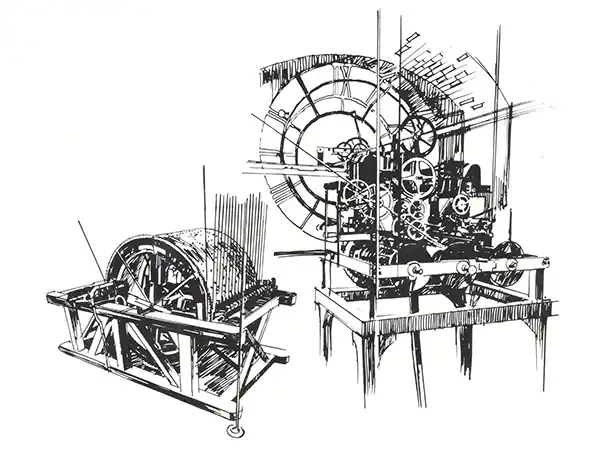Clock and Sundial

A Whitehurst-designed sundial was erected in 1785 on the south wall of the church.
While sundials predate mechanical clocks substantially as horological devices, it is worth noting that the church clock was installed in the tower in the same year.
Installed by John Whitehurst of Derby in 1785, the clock has three external dials, facing North, South and West out over the market place. Unusually the clock’s pendulum, hanging down into the ringing chamber and visible through the west window, swings with a 2 second period. The clock is wound weekly by the bellringers, and serves as a timepiece for visitors, shoppers and residents of the town.
The illustrations show the carillon (left) and clock mechanism (right).
It is housed in the Clock Chamber above the Bell Chamber.
The clock cost £203 in 1785, of which the 1st Earl of Uxbridge, Henry Paget, donated £100. This equates to about £40,790 in 2023.
The clock is known locally as the “Tower Clock”. It was donated by William Bass (1717-1787), a member of the prominent Bass beer-making family in the town.
It was originally a completely mechanical clock. In 1893 it was replaced with an electric system, which gave more accurate timekeeping. But this was undone later.
It has four large dials, one on each side of the tower, facing north, south, east, and west. The dials are made of metal and are painted black with gold Roman numerals.
1957 Upgrade
The clock chimes were silent for some years until 1957, because the wining task required heavy manual labour. The Feofees of the Burton upon Trent Consolidated Charities paid £350 for an electric winding system to be installed.
Today
In recent years, further repairs and maintenance have been carried out to preserve the clock. The clock’s mechanism was restored to its mechanical operation in the early 2000s, reverting back to its original design and contributing to its historical significance.
Tunes and Chimes
The clock features a sophisticated tune-playing mechanism, which performs the following automatically.
- It chimed every quarter hour.
- I played a melody the hour – a different traditional melody for each day of the week.
Today, the chimes may be heard at 9am, midday and 4pm from Monday to Saturday, and at 9am on Sunday.
The melodies are listed below.
Sunday 104th Psalm O Worship the King.
Monday Highland Laddie. A Scottish folk tune “If Thou’lt Play Me Fair Play”.
Tuesday Seeny Simon
Wednesday Lass of the Mill
Thursday Pretty Polly
Friday 66th Psalm All the earth shall worship you, O Lord
Saturday One evening, having lost my way. This tune originates in 1718, but was used in several popular shows, and early one being Beggar’s Opera in 1729.


